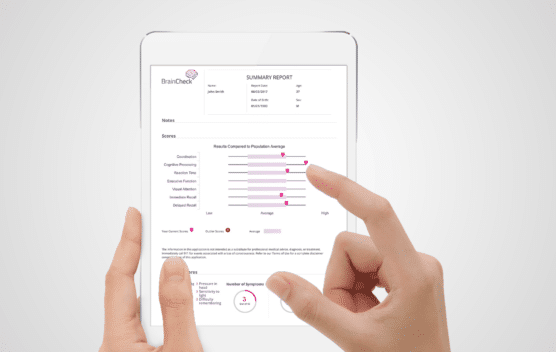Video transcription
Neurocognitive testing is a way to measure brain function non invasively. It uses paper-and-pencil tests or computerized tests to assess important aspects of cognition: attention, memory, language, reaction time, perception, and so on.
This isn’t about asking someone how they’re feeling or doing, it’s about giving small tasks that directly measure that. The different tests are specifically crafted to measure particular aspects of brain function. By measuring subtle aspects of brain function, researchers and clinicians can get a powerful microscope into what’s happening under the hood.
In this way, neurocognitive testing gives a standardized way to get a snapshot of brain health. The tests are objective, and the scores give a way to compare a person’s functioning to the rest of the population, or against themselves at a previous time.
The advantages of neurocognitive testing
Neurocognitive testing has several advantages over more invasive tests: it doesn’t take much time to complete, and unlike brain scans that are very costly, or surgeries that involve risks, this kind of testing can be done at a desk or on a tablet.
Collectively, the scores can be used to measure brain function, and in a clinical setting are often used for the diagnosis of problems, such as concussion, dementia, or learning disabilities.
Detect problems early on
Neurocognitive testing can help detect problems early on. Because they’re accompanied by subtle changes in attention, perception, and hand-eye skills. Those changes can be picked up with simple tests. And that can help determine someone’s fitness for returning to work or athletic play, or their capacity for living alone and managing their own finances.
Neurocognitive testing can tease out the patterns that allow detection, and can also allow tracking through time, for example, to keep a good baseline of your cognition in mild cognitive dementia, or to assess recovery in concussion.
Neurocognitive testing has been in use for a long time. Traditionally, it has been done with paper and pencil — but in recent years computerized neurocognitive tests have been shown to be even more sensitive and more efficient than the traditional tests. And it’s not surprising. We can capture precise reaction times, randomize trials, keep attention focused, be consistent, and score totally objectively. These tests can be run without a professional to administer them, which means they can be run more often, in the privacy of a home or on the sidelines of a playing field.
Related: Examples of Neurocognitive Testing: Neurocognitive Series, Part 2
Given these advantages, my lab and others have been gamifying tests on mobile devices. This makes the testing portable and easy to use, giving users the ability to take the tests early and often.
Having the ability to track cognitive health throughout an individual’s lifetime allows for a deeper understanding of brain health, allowing someone to take early action.
In the next videos, we’ll show you specific examples of the tests we use and what they tell us. We’ll also tell you how the scoring works, and why the collection of big data will move us forward in some of the biggest challenges in brain health.
